I’ve been planning to upgrade my surround sound system to Dolby Atmos ever since the format was first announced for home use. Due to a variety of delays, some financial and some personal, I put off the installation of an Atmos-capable A/V receiver until after Christmas this year. Now, finally, the time has come to connect the new equipment and step up to the next generation of home theater audio!
I’ve explained the concept of Dolby Atmos in previous articles (here, here and here). For home theater purposes, the main takeaway is that Atmos fills your room with sound from two auditory planes. The format is built off a traditional base of 5.1 or 7.1 speakers at ear level, and then adds a second layer of sound from overhead. This can be achieved either by mounting additional speakers high in your room, or by using special “upfiring” Atmos-enabled speakers (or speaker modules) that project sounds from ground level to bounce off your ceiling.
The home theater version of Atmos is a flexible format that can accommodate a number of different configurations, from a minimum 5.1.2 layout (that’s 5.1 channels on the ground and 2 height channels) to a theoretical 24.1.10 discrete speakers. For both practical and financial reasons, support for really high speaker counts will be the domain of high-end, extremely expensive boutique products. The majority of current-generation Atmos receivers top out at 7.1.4. Realistically, that should be plenty, even for large home theater rooms.
The Hardware
Because I’m coming from a 7.1 system, I chose to go for a full 7.1.4 Atmos configuration. To do that, I needed two new pieces of gear (in addition to the new speakers, which I’ll get to shortly).
I’ve been a loyal Denon customer for many years, so the Denon AVR-X5200W receiver was a natural upgrade path. However, although it can decode up to 7.1.4 channels for Atmos, the receiver only has nine channels of built-in amplification. In order to power all eleven speakers, I also needed a separate two-channel external amp. For that, I went with the Emotiva UPA-200. Admittedly, that particular model is probably overkill just to drive a pair of height speakers. (The AudioSource AMP-100 is a popular, inexpensive alternative for that.) As such, I’ve decided to use the Emotiva amp to power my main front left and right speakers, while the amps in the receiver will handle everything else.
Speakers
Honestly, buying a new receiver and amp was the easy part. Upgrading my speakers was more complicated for me. I’ve been pretty happy with the speakers that were already in my system, and had neither the desire nor the budget to replace all of them. Unfortunately, the manufacturer, Cambridge Soundworks, has suffered a downturn in recent years and exited the home theater market a while back. Because the company doesn’t make HT speakers at all anymore, it’s not possible for me to buy matching Atmos-enabled upfiring modules from the same brand. While I could just add new speakers or modules from a different company, I prefer not to mix-and-match speakers across separate brands, because I worry about timbre mismatching and don’t entirely trust EQ manipulation in the receiver to guarantee a consistent sound.
After thinking this over, I found that my best solution was to monitor Craiglist and eBay for used Soundworks speakers that could complement what I already have. Eventually, I acquired a set for a fairly reasonable price, which worked out nicely.
That wasn’t quite the end of the hassles, though. I agonized over speaker placement for a long time. Because my room was only wired for 7.1 when I built the home theater, and because my Surround and Surround Back speakers were already mounted in place and unmovable, I had to work around my former layout when planning the new one. This resulted in some compromises.
The height channels in an Atmos system offer the following options for placement:
- Front Height – High on the wall directly above the main left and right front speakers.
- Top Front – Mounted to the ceiling forward of the main speakers, between the front soundstage and the listening position.
- Top Middle – Ceiling mounted slightly in front of the listening position.
- Top Rear – Ceiling mounted behind the listening position, between the seats and the Surround Back speakers.
- Rear Height – High on the wall directly above the Surround Back speakers.
Further, when configuring for four heights, my new Denon receiver prohibits the two pairs from being directly adjacent to one another. They must be staggered with spacing between them. Therefore, you cannot install Front Height and Top Front simultaneously, or Top Middle and Top rear. There must always be an unused position or more between each pair.
As I mentioned earlier, Atmos is designed to have a base layer of 5.1 or 7.1 speakers at ground level and additional channels above. This proved problematic for me, because my Left and Right Surround speakers had been mounted high on the side walls, and my Surround Back speakers are on the ceiling.
When I brought in my electrician, we determined that it would be fairly easy to snake new speaker wire behind the front and left side wall of the home theater, but very difficult (and expensive) to run any above the ceiling. This effectively ruled out mounting new speakers to the ceiling unless I wanted visible wiring across it, which I certainly didn’t.
Ultimately, I came to the conclusion that my best option was to configure the height channels as Front Height and Top Middle.
I mounted the Front Height channels high on the left side wall and the support beam soffit on the right.
Next, I rewired my former Left and Right Surround speakers, which were already up near the ceiling, to become the new Top Middle channels. I then added new speakers on stands below them at ear level, which will be the new main Surrounds. My Surround Back speakers will remain where they were, on the ceiling.
This is not ideal for a few reasons. The Surround Back speakers should be at ground level, not up high. I suppose I could have reconfigured those speakers to be Top Rear or Rear Height channels, which would leave me with a 5.1 base and no Surround Backs, but I didn’t want to give up the Surround Backs. Also, the receiver is not capable of doing six height channels. Since the high speakers to the sides of the seats were already fixed to those positions, this would have forced me to use Top Middle and Rear Height, leaving me without any height channels in the front of the room. That seemed like a bad idea. The way it is now, the Surround Backs are far enough away from the seats that I expect the height level won’t really be too critical for those channels.
More concerning is the fact that the Surrounds and Top Middle speakers are too close together without enough separation, and the Top Middles really should be on the ceiling. I fear that this may leave me with a gap in the soundstage above the seats, but I’ll need to do a lot of testing to see if that’s really a problem.
Life is a game of many compromises, and this was the best compromise I could come up with given the limitations I faced.
What’s interesting is that this speaker layout is actually quite close to being in line with recommendations for the competing Auro-3D sound format. Denon offers an Auro firmware upgrade for the X5200W receiver that I may check out in the future. (There is a fee for that update, unfortunately.)
Wiring It Together
The two speakers that are currently my Top Middles on the left and right were previously wired before the walls or ceiling in the room were built. For the new equipment, my electrician was able to run speaker wire behind the walls in the front and to the left of the room, so the speakers on that side came out very neatly.
We were not able to get any wire through the support beam soffit on the right, however. For that side, I had to sneak some wire up the back of one support pole near the receiver, run it on the other side of the soffit, and then drop it down behind another support pole. Fortunately, this is mostly hidden out of sight and shouldn’t draw attention to the wires.
Here’s a peek at the jungle of wiring behind my equipment rack, also hidden from view.
Next Steps
With the physical labor out of the way, I spent a lot of time last night programming the receiver and running an Audyssey MultEQ XT32 calibration. I was then able to play some Dolby trailers from a demonstration disc provided by Dolby Labs to confirm that everything is working and sounds are coming from where they’re supposed to. Initial results sounded very good, but it got to be very late and I haven’t done much critical listening yet. Beyond the test disc, I also have the Atmos Blu-ray for ‘Transformers: Age of Extinction’. I look forward to watching that, as well as testing out the Dolby Surround upmixing of standard Blu-ray 5.1 and 7.1 soundtracks. I’ve been told that the receiver does a very good job with that.
This should be the fun part. More to come!

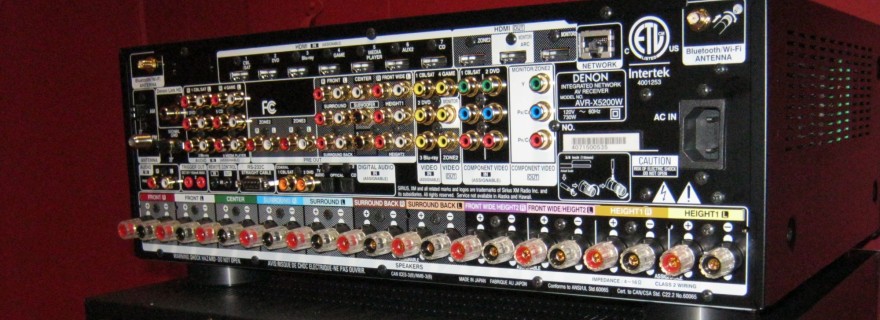
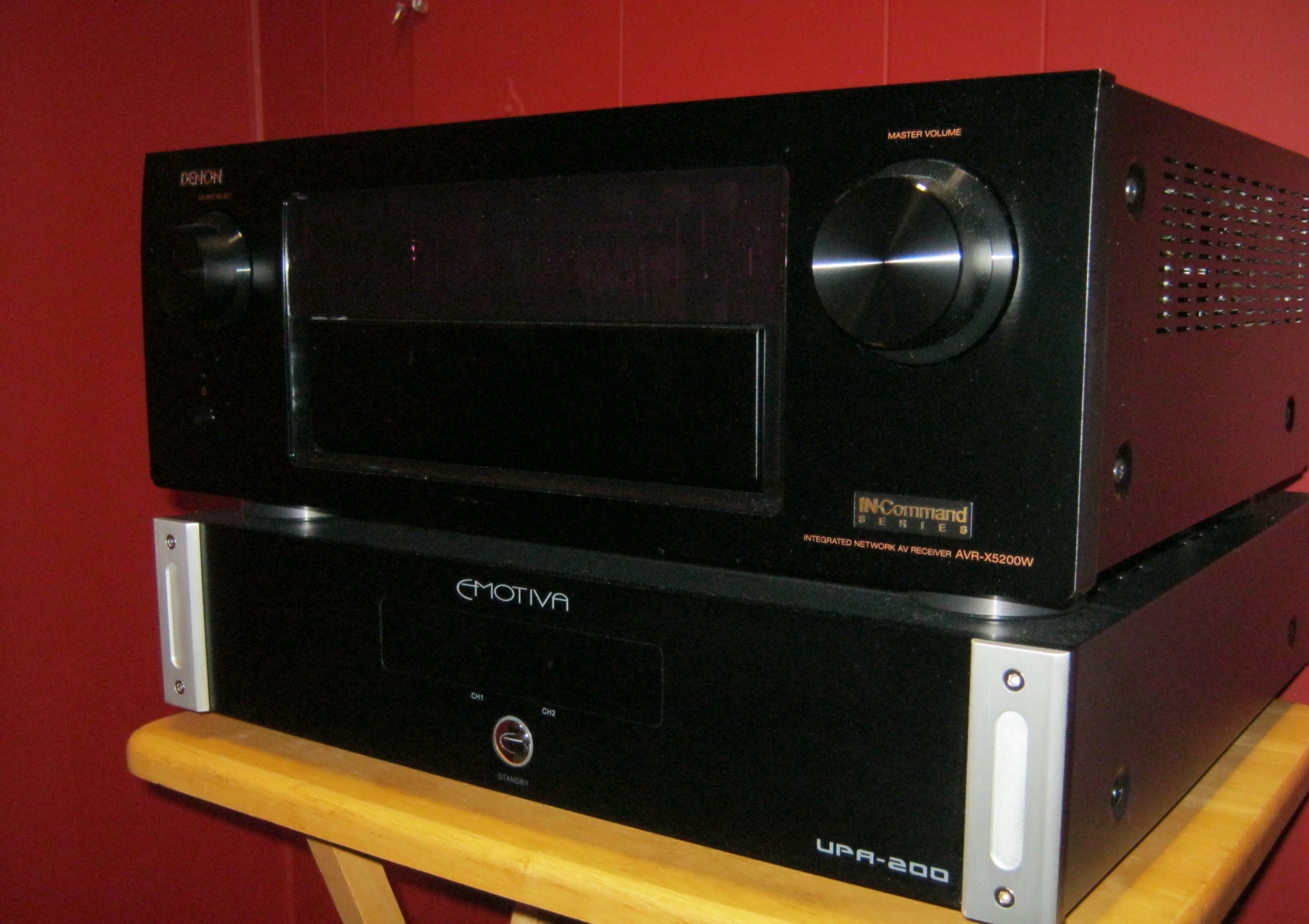
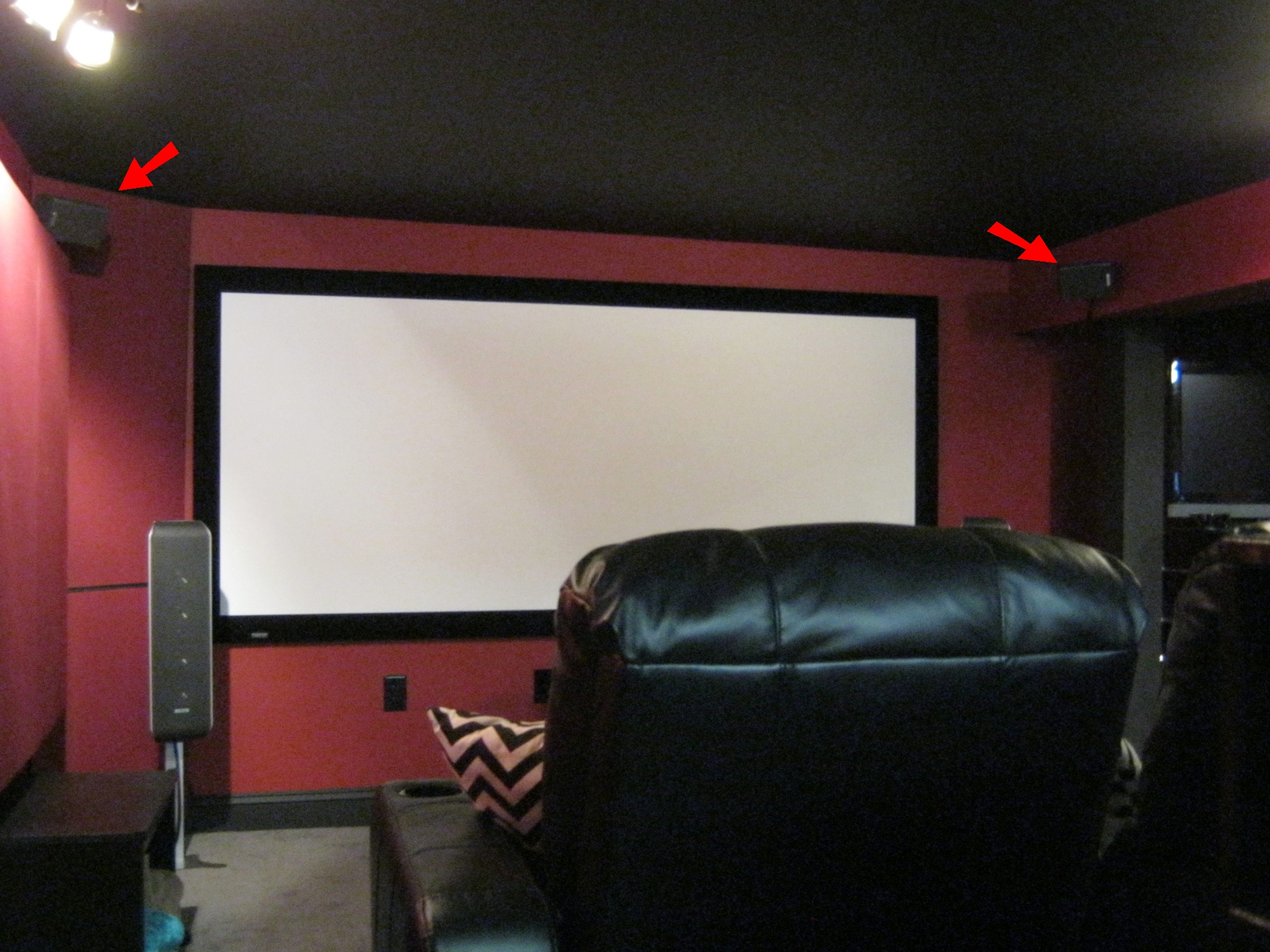
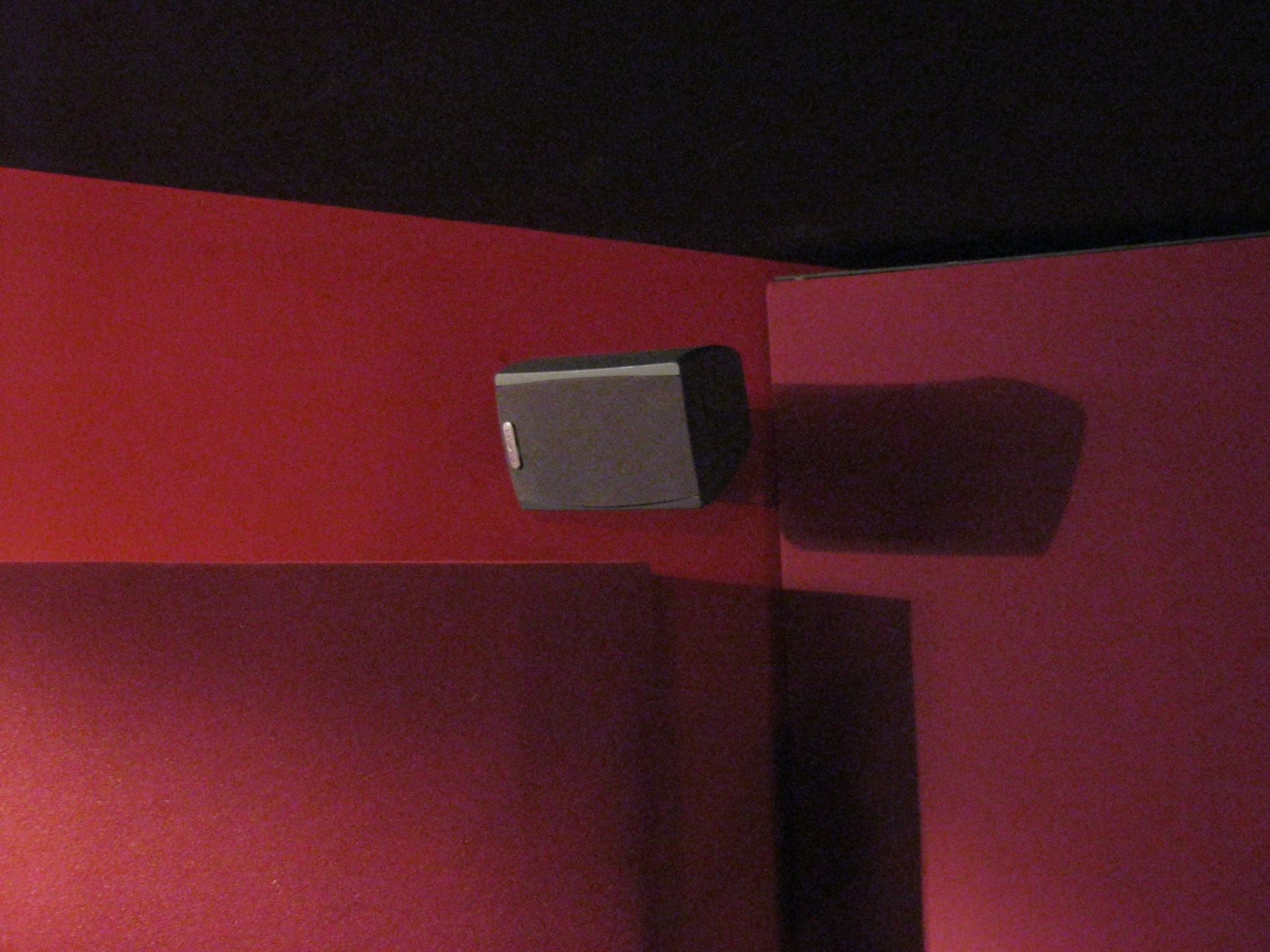
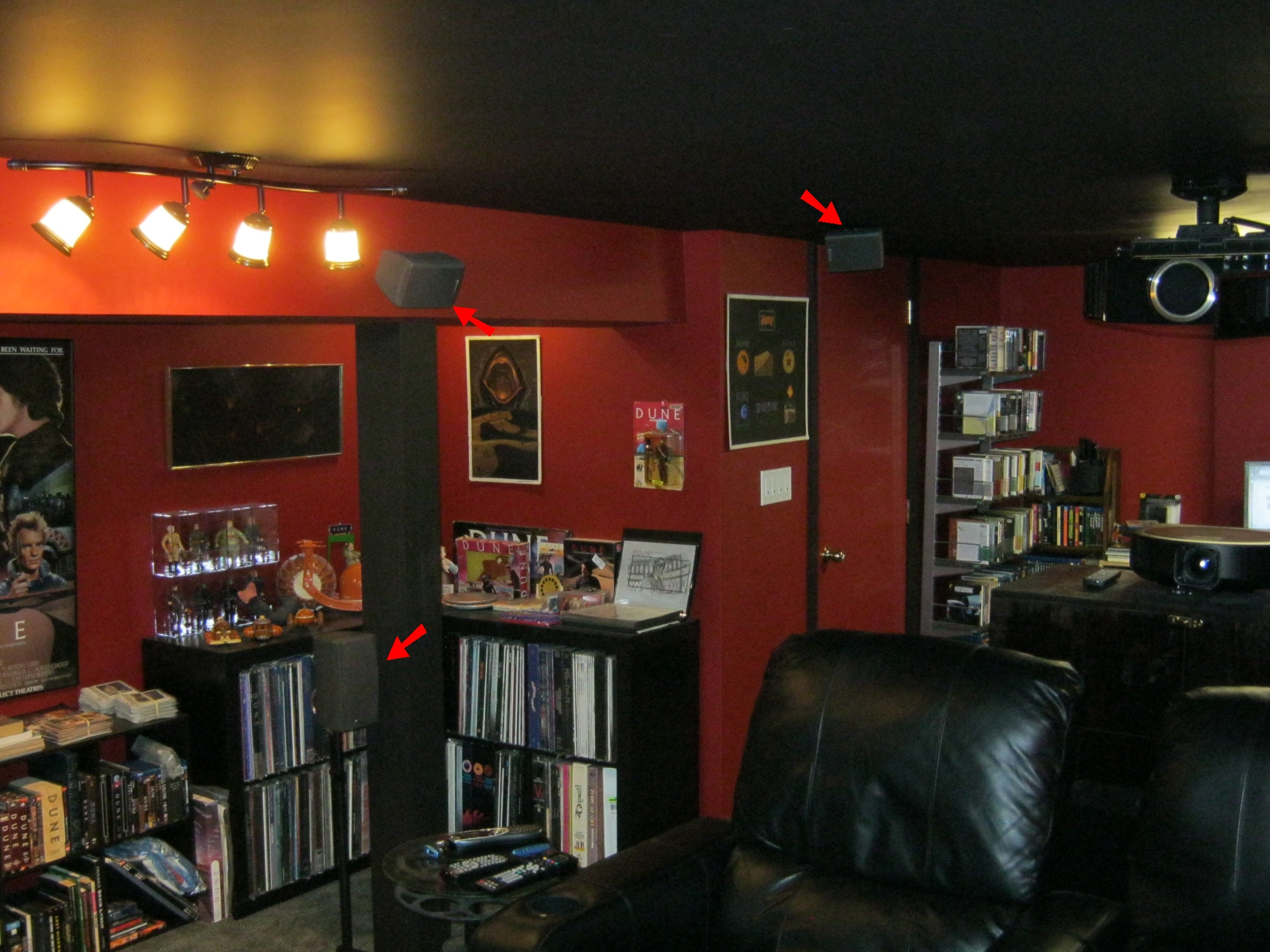
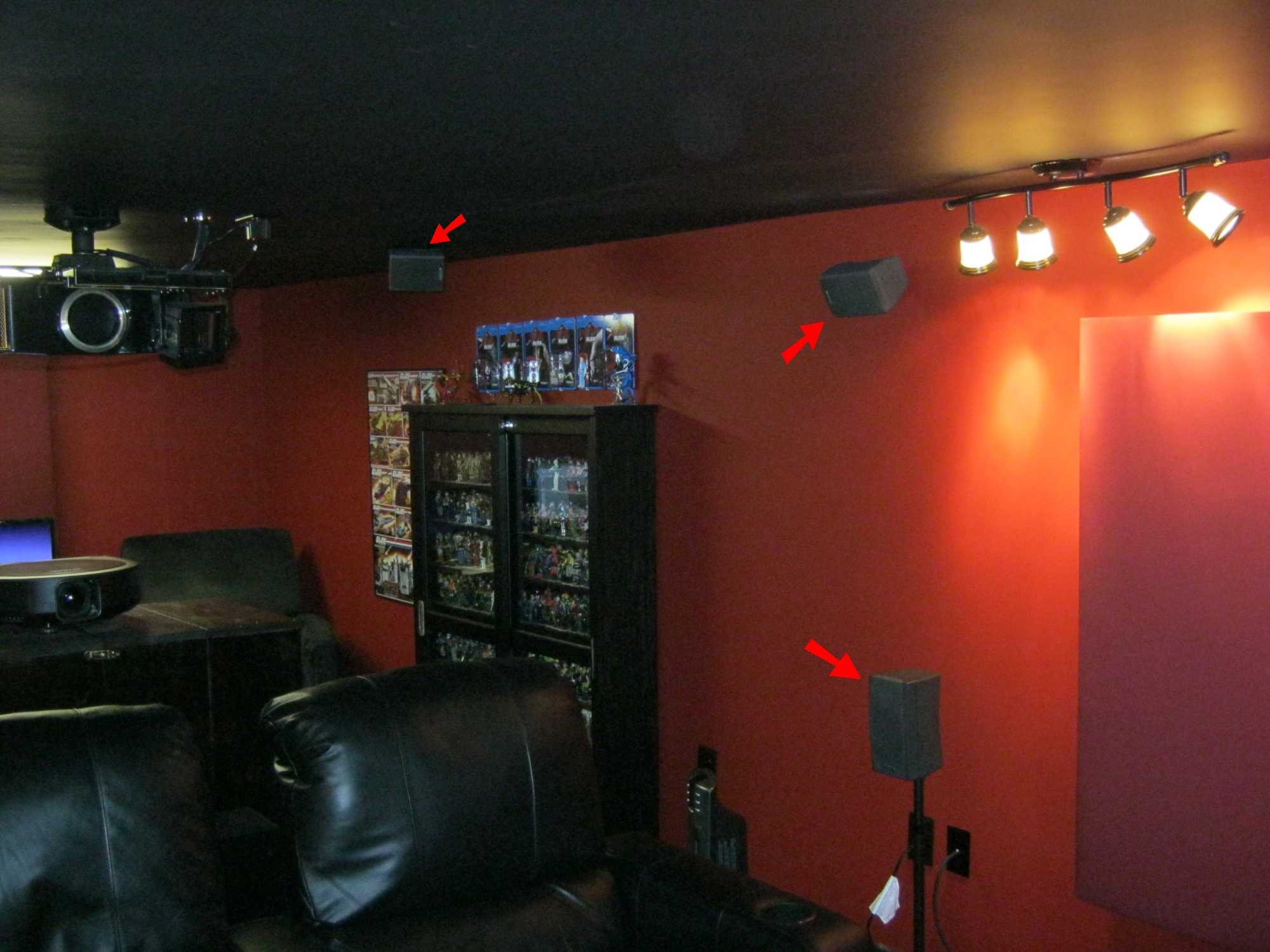
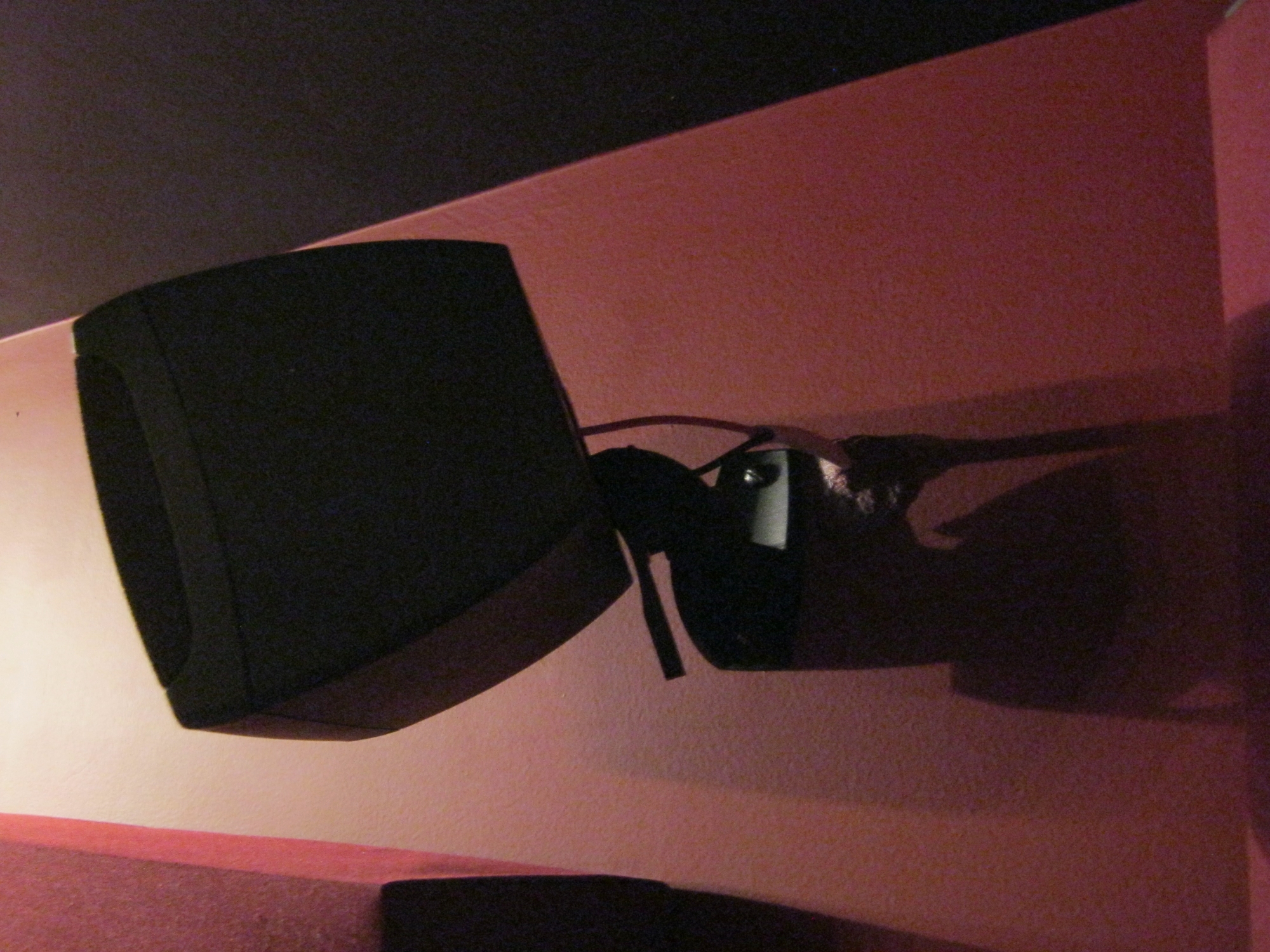
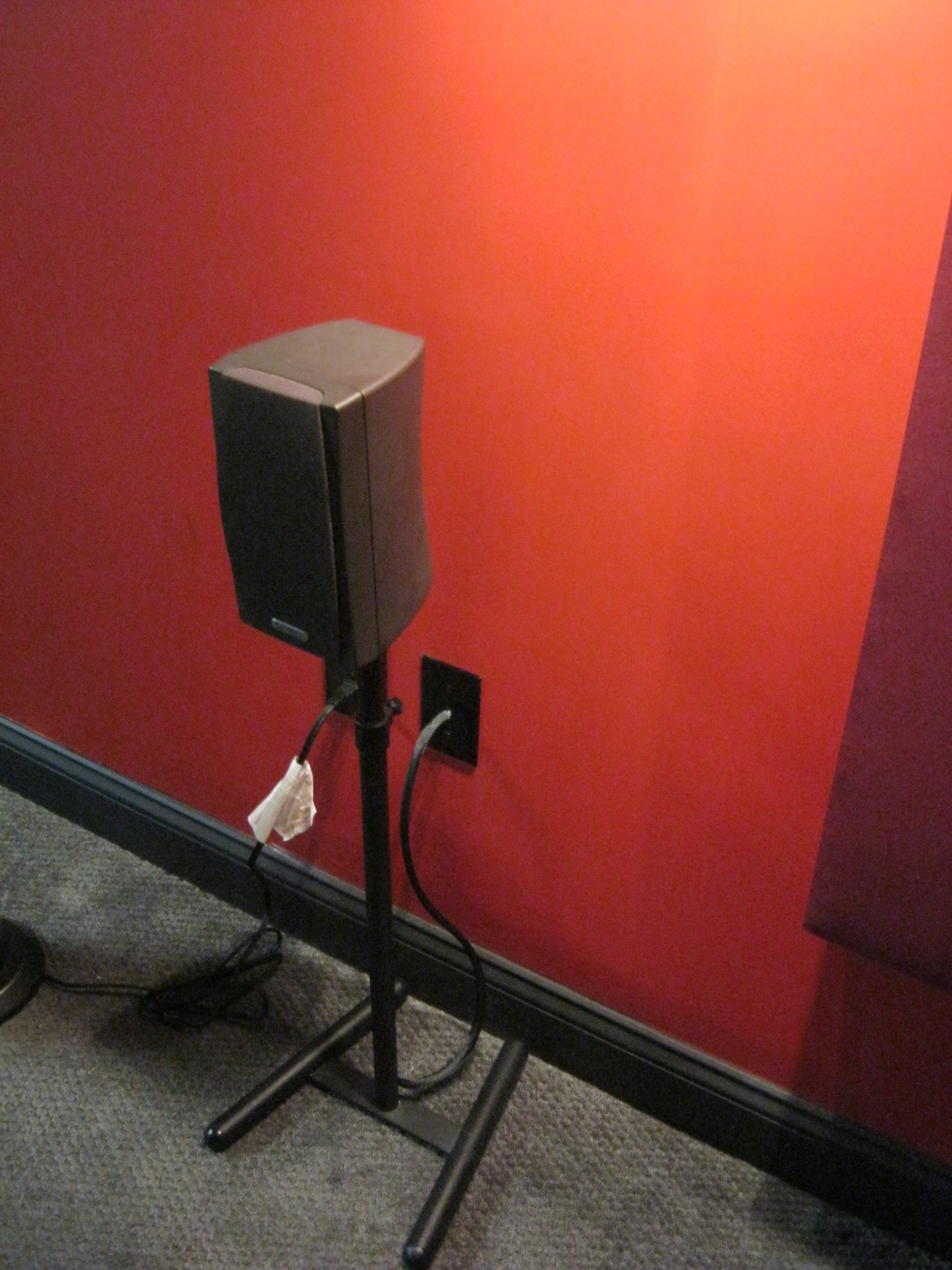
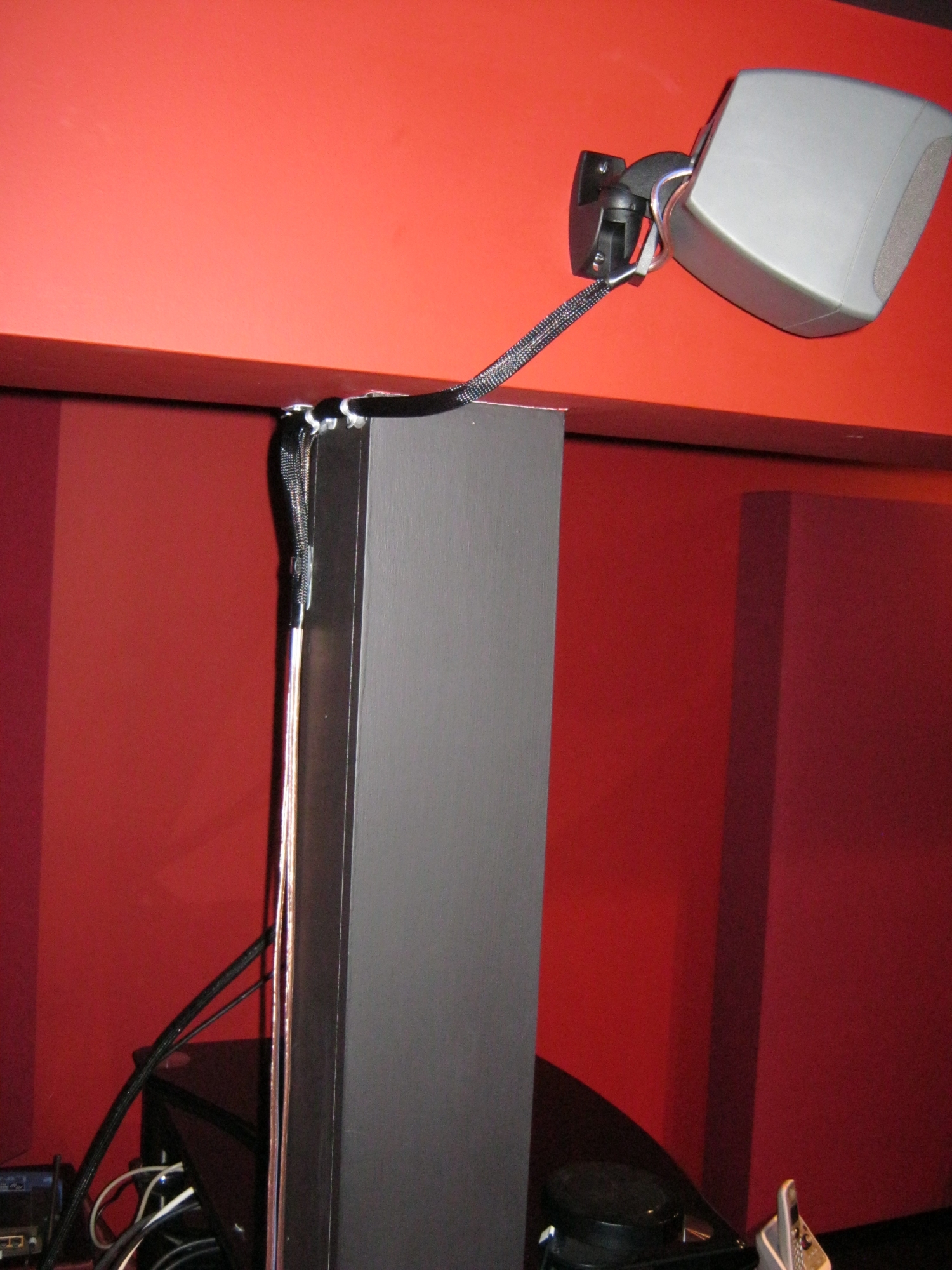

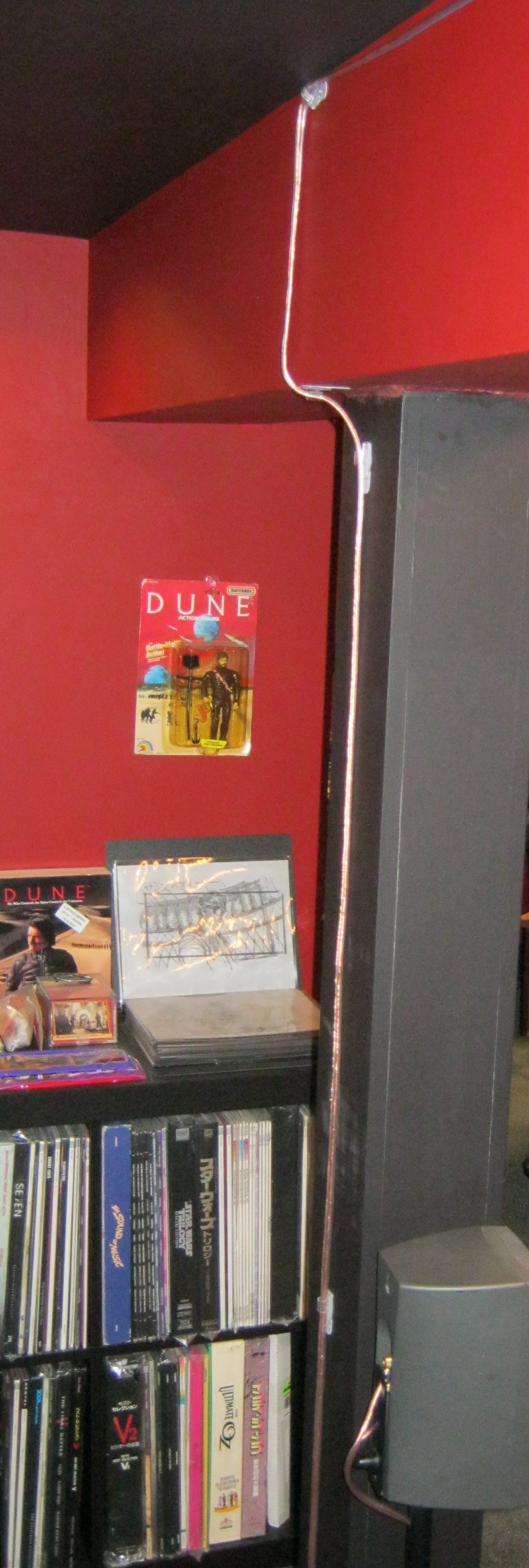

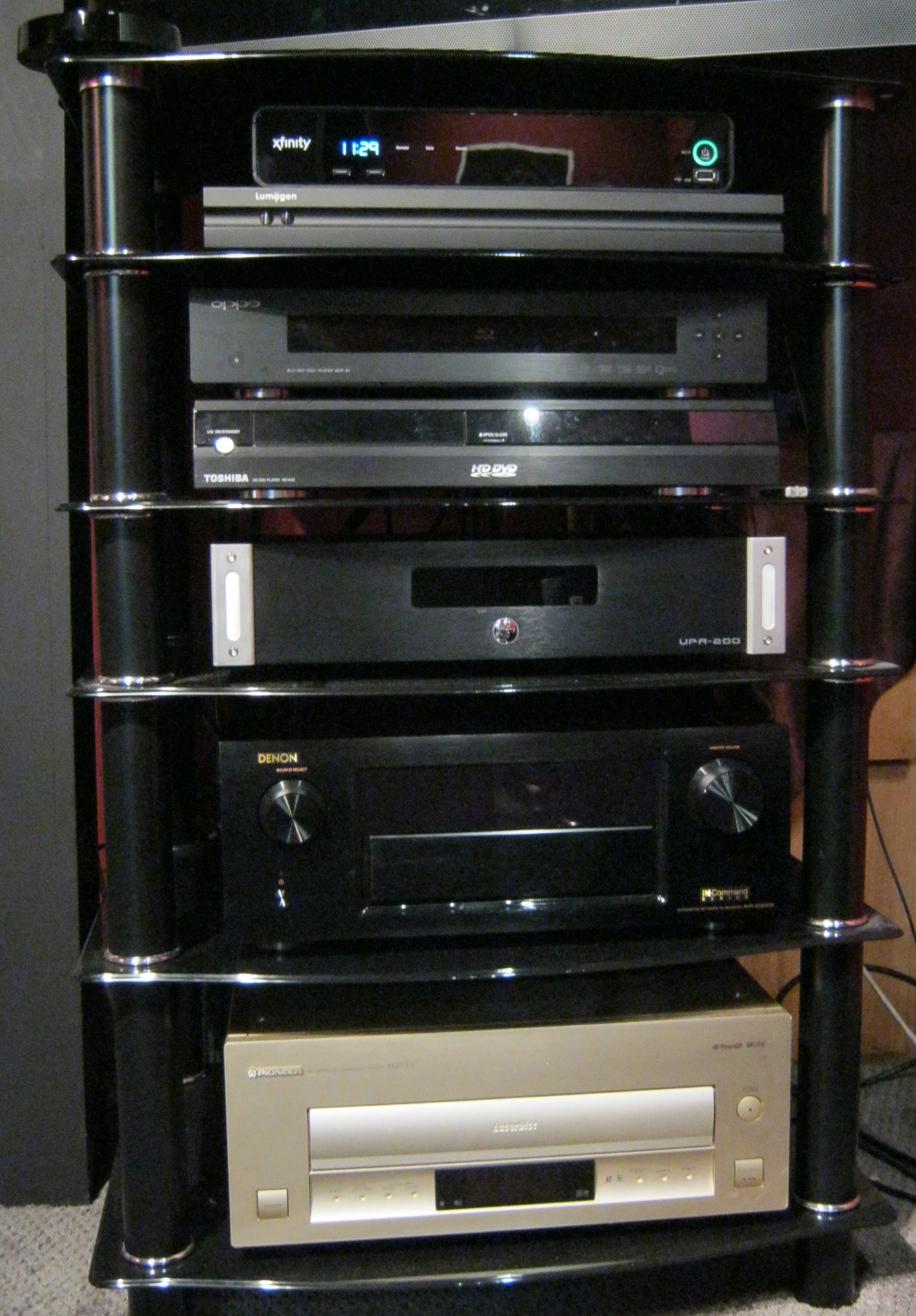

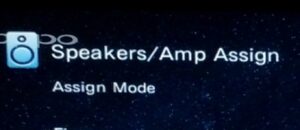
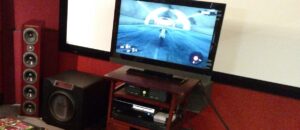
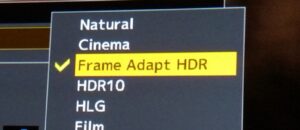
Csm101
So I just saw the post with DTS: X coming out sooner than later, do you know if your new receiver will have some kind of update for that format or are you not concerned with DTS: X? Do you have a tv watching family room in your home upstairs and if so, do you have surround there too? Just curious.
Josh Zyber
AuthorThat announcement about DTS:X certainly comes at an unfortunate time for me. I had assumed the format wouldn’t be ready until late 2015. Now I feel like I should have waited.
It remains to be seen whether my receiver can be upgraded by firmware. Hopefully that will turn out to be the case.
Deaditelord
Is this the DTS headphone format that wowed people back in 2013 or is this just DTS’ version of Dolby Atmos?
Shannon Nutt
It’s DTS’s successor to DTS-HD Master Audio. It has nothing to do with the “3D” headphones they came out with, which also have the “X” label. It just seems to be the letter they’re using for all their latest innovations.
Deaditelord
Excited to hear your results Josh. I’m on the fence about upgrading to an Atmos setup and your comments will certainly go a long way in helping me make a decision.
Ramzy
Curious to see if you can hear a difference with your main speakers using the Emotiva as well as your thoughts on the upmixing
andy
Loving the Laserdisc player!!!
Josh Zyber
AuthorOne thing I forgot to mention in the article is that I had to take everything out of and disassemble my equipment rack in order to add an extra shelf for the new amp. It used to only be four shelves tall. I contemplated removing the Laserdisc player, which I never use anymore, but just couldn’t bring myself to do it.
William Henley
I took the laserdisc player out of the entertainment center and moved it to the bedroom. It is like the one thing to survive the fire as it was out getting repaired at the time. Laserdiscs are like $2 at Half-Price Books. Anyways, in the bedroom, I have an older tube SD television. For some reason, analogue sources look significantly better on a tube than they do on a digital display (I guess either cheap comb filters, or – and correct me if I am wrong, but I think analogue displays had round pixels and digital displayshave square, or somehting like that. But whatever the reason, the laserdisc player is now in the bedroom, where it actually gets used. Yeah, no surround sound in the bedroom, but in my opinion, it looks significantly better hooked up to the tube than it did to my HDTV in the living room
frankie
Analog sources DO look worse on digital displays. I remember being pissed off after buying a “fancy new” flat panel TV only to have everything I had at the time hooked up to it look worse, or even unwatchable than it did on the tube TV.
Josh Zyber
AuthorAnalog TVs don’t have pixels at all. They have phosphors that are sprayed on the screen with a scan gun. But yes, Laserdisc and other analog sources do typically look better on older analog sets, mainly because digital displays are so much more revealing and unforgiving of the flaws in the signal. The shadow mask in a CRT screen filters a multitude of sins.
In answer to your other question, I turned on the HD DVD player last night when I was reprogramming my universal remote to integrate the new receiver. Other than that, you’re right, it’s been a while. 🙂
William Henley
🙂 The annoying thing with my HD-DVD player was that it would never maintain its settings. If it was a PC, I would say that the BIOS battery was dead. Every single time I turned it on, I had to do it with no disc in, so that I could go the settings menu, set the date (it made me set the date before I could do anything else), then reset the video and audio options. The ethernet never worked until about 2 months after Toshiba killed HD-DVD with their last firmware update, and by then, most of the content providers had took down their servers.
As for the “pixel” shape, I am refering to this:
http://shmups.system11.org/viewtopic.php?f=6&t=43256&start=30
http://upload.wikimedia.org/wikipedia/commons/0/04/CRT_pixel_array.jpg
On older CRTs, the “dots” or “pixels” or whatever were round. On a digital display, pixels are square (I cannot add a picture of that because a third link would cause my comment to be thrown out automatically by the system). Anyways, wondering if that is why older stuff looks so much worse on digital displays. I mean, in addition to the fact that older sources are of lower quality.
William Henley
When is the last time you fired up the HD-DVD player? I have a feeling that you don’t have that many HD-DVDs left
Drew
Josh, my father-in-law wants to upgrade to Atmos. He’s on a limited budget. He’s looking into the Denon AVR-X4100W. By itself, I believe that receiver is capable of either 5.1.4 or 7.1.2. Is that correct? If he were to add a 2-Channel external amp, would he be able to do 7.1.4?
I know Marantz has a $2,000 model that is capable of 7.1.4, all by itself, but if he can get this $1,500 Denon plus a $170 two-channel external amp, and do 7.1.4 that way, it would save him $330.
I’m almost certain that he will be able to do 7.1.4 with the 4100W, plus an external two-channel amp. I’m hoping that you can confirm.
T.J. Kats
This is what the audioholics preview of the 4100 says
“This opens up three possible Atmos configurations: 5.1.2, 5.1.4, and 7.1.2. These configurations are based on conventional 5.1 and 7.1 surround setups, but add either 2 or 4 in-ceiling/ceiling mounted or Atmos Enabled speakers to the mix.”
Looks like it only has 7 internal amp channels and you can add two more channels worth.
Josh Zyber
AuthorOnly the X5200W and X7200W can do 7.1.4, sorry.
It’s a few months old, but see Steven Cohen’s Atmos Buying Guide here:
http://www.highdefdigest.com/news/show/Dolby_Atmos/Atmos/Speakers/Receivers/Home_Audio/Pioneer/Denon/Marantz/Integra/Yamaha/Onkyo/Dolby/KEF/Definitive_Technology/Atlantic_Technology/highdef-digests-dolby-atmos-home-theater-guide/17777
Your father-in-law would probably be best advised to wait a few months until the news models with both Atmos and DTS:X start coming out.
Krawk
Josh – how well does the Audyssey work with the extra external amp?
Josh Zyber
AuthorSeems to work fine. It calculated speaker distances to those channels correctly and shows EQ adjustments. The amp is basically plug-and-play. I connected two coax cables into it (from the receiver’s pre-outs) and some speaker wire out of it, and the receiver does the rest. Oh, and a cable for the trigger-out/trigger-in. The receiver even tells the amp when to turn on and off.
Jim
Josh, this is exciting – great report & great explanations as always. The compromises you are kind of stuck with -at this time- actually make the article more interesting from a reader’s perspective. But ultimately, I hope you get the desired results. Looking forward to more ♫! -Jim
Freakyguy666
JZ, I read in an earlier post of yours that you would have liked to hear the 7.1.4 demo against a 9.1 or 11.1 where the surrounds are set higher than ear level. Well, I’ve had the opportunity to hear such a demo…so far none of the blurays seem to present a significant improvement upon the latter set-up. There were a few moments where it seemed there may be a slight benefit to the ATMOS track but most listeners were underwhelmed. Just FYI…
João Guilherme
“I look forward to watching that, as well as testing out the Dolby Surround upmixing of standard Blu-ray 5.1 and 7.1 soundtracks. I’ve been told that the receiver does a very good job with that.”
As there are very few Atmos enabled blu-ray discs (as far as I know only four right now) I believe it should be crucial to you to see the upmixing working fine, right?
Or are you glad to just wait for new discs?
M Matthew Eizenga
Can I just say it makes me very happy to see you have the HD-XA2 still connected. I do as well. One of my favorite peices, still pissed off at HD DVD for losing.
Csm101
Have you had a chance to watch some Atmos movies yet? Which ones did you find to be the best? Is it easy to compare the Atmos with the 7.1 TrueHd? I’m assuming the new receiver will automatically play the Atmos track. What I’m trying to say is what do you have to do to watch the TrueHd track vs the Atmos track? Do you have to change the settings in your player or receiver or does an extra icon pop up giving you both options to choose from? Can you upscale the 7.1 TrueHd version of an Atmos track (for shits & giggles) if you wanted to?
Josh Zyber
AuthorIf a disc has an Atmos track and you transmit that by Bitstream, the receiver will automatically decode the full Atmos. If you want to only listen to the 7.1 downmix (for comparison purposes), you would have to switch the Blu-ray player to decode internally and output PCM. The Blu-ray player can’t decode the full Atmos itself, so you’ll get the downmix.
And yes, you could apply Dolby Surround Upmixing to that 7.1 afterwards.
I have not had an opportunity to test this and compare the results yet.
Freakyguy666
Would be interested to see if your receiver allows the ATMOS mix to be played when only a 7.1 speaker configuration is present as Dolby has stated is possible.
Josh Zyber
AuthorThere’s no reason this wouldn’t be possible. You just tell your receiver how many speakers you have during set-up. Even Dolby ProLogic can fold down a multi-channel soundtrack to a smaller number of channels. There’s no special magic to that.
Freakyguy666
I was referring to the ATMOS mix, not a folded-down version of it–which would display on the receiver as true-HD-not ATMOS.
In other words, can you get the ATMOS mix without overheads?
Josh Zyber
AuthorGo into the setup menus in your current receiver and tell it that you only have two speakers, the front left and right. Then send it a TrueHD or DTS-HD MA track from a Blu-ray. What happens? The receiver still reports receiving the TrueHD or DTS-MA track, but folds it down to two channels. All of the sound effects are still in there, and are still lossless, but get redirected to the mains. Same concept here.
Atmos is just an extension of TrueHD. If you only have 7.1 channels in your home theater, the Atmos mix is going to get folded down to 7.1 one way or the other, whether you have an Atmos receiver or a standard TrueHD/DTS-MA receiver.
If you have an Atmos receiver but only connect 7.1 channels to it, the receiver will report receiving the Atmos signal, but your results will sound the same as a 7.1 TrueHD fold-down on a regular receiver. So there’s not much point to doing that, unless you’re future-proofing for a speaker upgrade later on.
Freakyguy666
JZ, you said, “If you have an Atmos receiver but only connect 7.1 channels to it, […] your results will sound the same as a 7.1 TrueHD fold-down on a regular receiver.”
The above is becoming a point of contention among ATMOS users. According to Dolby, when a disc containing an ATMOS mix is processed via an ATMOS receiver and heard in a 7.1 configuration, the resulting soundscape is not equal to the same disc played via a non-ATMOS capable receiver in the same 7.1 room. The reasoning being that there is no ATMOS object rendered within the non-ATMOS receiver to place the objects as they were originally intended in the ATMOS mix.
If true, this would imply that users with no overhead speakers would benefit from an ATMOS receiver as long as they have a 7.1 or 9.1 (7.1 + 2 wides).
Josh Zyber
AuthorI would have to talk to Dolby about this, but it’s my understanding that if you play an Atmos disc in a non-Atmos receiver, you don’t lose any sound effects or audio. It all gets folded into the 7.1.
Consider an Atmos mix with the sound of a plane flying overhead through the height channels. If you played that on a regular 7.1 receiver, would you not be able to hear the plane at all? That would seriously compromise the artistic intent of the movie. It seems highly unlikely that anyone at Dolby would be that short-sighted.
Remember that Blu-rays with Atmos do not have separate, dedicated 7.1 mixes for non-Atmos viewers. The Atmos is intended to be the default soundtrack backwards compatible for all listeners.
Freakyguy666
I also don’t think you would lose any audio or sound effects via a non-ATMOS receiver. However, you would potentially lose directionality and object placement. Recall that ATMOS is more than just additional overhead channels. IT IS AN OBJECTS-BASED RENDERER and according to Dolby it can render objects within a room with a 7.1 or 9.1 (2 wides) withOUT overhead speakers. Now, some may argue that it will not sound as good as a room that is 7.1.2, but at least according to Dolby, the objects would still be rendered within the room–with the overhead sounds presumably folded down into the 7.1 layout.
Josh Zyber
AuthorI’ve been away from AVSForum for a few weeks, and the threads there move too quickly to keep up with. Are people actually claiming to have done listening comparisons for this? It seems to me that someone is probably just misinterpreting something they read from Dolby.
First off, the majority of audio in the height channels are non-directional ambient effects like wind or rain anyway. Even in the Atmos “Amaze” trailer on the Dolby demo disc, the “listen to the sound of this bird fluttering all the way around the room” scene is entirely at ground-level, with some non-localized tree rustling effects overhead.
I think people are fretting over nothing here. At best, there might be a very subtle difference in the fold-down between an Atmos or non-Atmos receiver. Is that worth buying a whole new receiver for, if you don’t plan to do the speaker upgrade with it? IMO, I don’t think so.
Freakyguy666
I think that you may be implying that simply because the audio is coming out of the ground-level speakers, there is no difference between the way the object is rendered via an ATMOS receiver vs a non-ATMOS receiver.
Dolby says that there is a difference in the experience because the ATMOS mix has been designed to be decoded via ATMOS so that the up to 118 object could be “placed” in the room. A non-ATMOS receiver simply cannot decode the object-based information and simply cannot provide the accuracy that is intended.
Josh Zyber
AuthorBut you’re talking about sound cues that, for the most part, don’t require that much precision. The majority of important directional effects will be mixed in the 7.1 base.
This really seems to be an argument of theory vs. practical real-world application and results. I listened to all the trailers on the Atmos demo disc on my old receiver before I installed the new one. They all had plenty of directional effects in the 7.1 fold-down. Do they sound even better when I upgraded to Atmos? Of course, but I wouldn’t say any of them were disappointing beforehand.
Again, even if there is a difference in fold-down quality, it’s going to be subtle at best.
William Henley
My understanding is that with ATMOS, it detects where your speakers are from your listening position, and positions sounds in a certain soundscape. So the objects would be placed real-time. In a traditional 7.1 mix, the sound levels are hard-coded to the channels. So you could get a different sound mix with an ATMOS track played through an ATMOS reciever in 7.1 mode versus a 7.1 DolbyTrueHD track. That being said, unless you are just putting your ATMOS speakers in some unusual places, I doubt that someone would notice a dramatic difference. Someone would litterally have to listen to the two tracks back to back, tune their ears, and probably place their ears up to each speaker to try to determine if the sound level for an effect is the same out of each speaker.
So I really don’t see the reason for going ATMOS unless you plan for height or upfiring. Now, I DO plan to get height channels eventually, and am probably going to go 7.1.4. Will probably be a couple of years.
Josh Zyber
AuthorWhen Atmos was first developed, that’s how the theory behind it was described to me. In practice, however, the Atmos A/V receivers don’t have the computational power to detect the precise angular location of each speaker in your room and remix for that. When you set up the receiver, you have to choose from a list of pre-defined speaker locations per Dolby guidelines. Your ground-level 5.1 or 7.1 base is expected to follow a traditional layout. Height channels can be: Front Height, Top Front, Top Middle, Top Rear, or Rear Height. If your actual speaker locations don’t fit one of those definitions, you have to pick the closest option.
Dolby has said that the height channels are flexible enough that Atmos is kind of hard to screw up. Even if the speakers aren’t precisely within recommended guidelines, you’ll still probably be fine so long as they’re close enough. Again, this goes to my point about how most of the height cues are non-directional ambient sounds anyway.
But no, if you put your speakers in wacky asymmetrical locations or accidentally mis-wire the speakers for the left to the right and vice versa, the receiver will not automatically detect and correct for that. It assumes that you’ve put the speakers where the guidelines recommend and will send sounds to the locations you’ve told it you’re using.
Freakyguy666
JZ, you said: “I listened to all the trailers on the Atmos demo disc on my old receiver before I installed the new one. They all had plenty of directional effects in the 7.1 fold-down. Do they sound even better when I upgraded to Atmos? Of course,…”
Well that’s all I’m saying. They sound better.
Now how about those who have 9.1 systems (2 wides)?
Would they not benefit from the ATMOS mix even more than those who have 7.1? From what I’ve read, the answer is a resounding YES! The reason being that current media encoded in Atmos RARELY uses the overhead speakers. In fact, in independent testing, the overheads were firing only 1% of the time during the 4 films that are out! As such, it stands to reason why those using ATMOS in a 9.1 configuration are actually reporting a better experience than when they switch to a 5.1.4. Interesting, no?
Josh Zyber
AuthorOf course the full Atmos 7.1.4 sounds better than the 7.1 fold-down. It has four extra channels to work with. I did not test the 7.1 fold-down with the old receiver vs. the new one, and have no interest in going through the tremendous effort to do so. Even if there is a difference, I still contend that it will be small.
When I listened to the Atmos trailers folded down to 7.1 on the non-Atmos receiver, I did not feel that they lacked any directional surround activity due to the receiver failing to decode them properly. All of the reviewers (on this site and others) who’ve watched Atmos discs like Transformers or TMNT on non-Atmos receivers have still given rave reviews to their 5.1 or 7.1 fold-downs.
You came here to ask my opinion, and this is it:
If you’re thinking of upgrading to a full Atmos system including height channels (whether ceiling-mounted speakers or upfiring modules), I say go for it.
However, if you’re thinking of upgrading to an Atmos receiver without also adding height channels, solely hoping to eke out a tiny difference in the 7.1 fold-down on the half-dozen Atmos Blu-rays available, I think you’ll be very disappointed and will find it a waste of money.
As for a lack of height activity in current Atmos discs, I think that’s something that will evolve as mixers get more comfortable with the format. Also, I find the 1% claim to be kind of dubious. If we’re only talking about discrete directional effects in those speakers, maybe that’s true, but the channels seem to get quite a lot of subtle ambient sounds and music that perhaps don’t draw attention to themselves.
Josh Zyber
AuthorAs for utilizing width channels in a 9.1 configuration, although the Atmos decoder can use the wides for true Atmos content, the Dolby Surround Upmixer is not compatible with width channels and will turn those speakers off. You’ll never hear those speakers unless you play a genuine Atmos disc. Given that the vast, vast, vast majority of content you’ll watch will have 5.1 or 7.1 soundtracks, you’ll get a lot more benefit from height channels, which are active with both Atmos and DSU.
If width channels are more important to you than heights, you’ll have to switch to either DTS Neo:X or Audyssey DSX, both of which are probably already included in your existing receiver.
Freakyguy666
JZ, you said, “I did not test the 7.1 fold-down with the old receiver vs. the new one, and have no interest in going through the tremendous effort to do so. Even if there is a difference, I still contend that it will be small.”
Based on those who HAVE gone thru the effort to perform this exercise, the results are actually quite substantial. And it makes sense given that the ATMOS mix is decoded differently in an ATMOS receiver than a non-ATMOS receiver. This is also consistent with the other tests that have demonstrated that the current discs on the market actually utilize the overhead speakers 1% of the time–99% of the time they were dead silent! (According to respected users on AVSForum)
Given that the overheads are (so far) used so infrequently combined with the fact that practically every single person who has heard these tracks in ATMOS & non-ATMOS swears that the ATMOS mix is vastly superior, it stands to reason that one owning a 9.1 or even a 7.1 would benefit substantially from an ATMOS receiver–even if they did NOT have any overhead speakers. It’s plain old logic!
Josh Zyber
AuthorI have a limited amount of native Atmos content to test. The Atmos trailers are perhaps mixed more aggressively than the first few movies have been. However, that 1% figure sounds like made-up bullshit to me, not an actual measured test.
Regardless, as I said, the vast majority of content you’ll watch will have 5.1 or 7.1 soundtracks you’ll need to run through the Dolby Surround Upmixer. Although many of the effects there may be subtle, the DSU keeps the height channels active pretty much all the time. Those channels are rarely silent with DSU. As in, almost never. There’s always some ambient sounds or music in the heights with DSU.
On the other hand, DSU is not compatible with width channels. Those speakers will be completely silent except on native Atmos soundtracks. We’re up to how many of those now? Four? (Not counting the promotional trailer disc.) And of those four titles, how many are watchable movies? So far, none. A reissue of Gravity is coming soon, so I guess that’ll bring us to one solitary watchable Atmos Blu-ray. Unless you prefer to watch that movie in 3D, in which case you’re screwed and will have to resort to the 3D disc with 5.1 sound.
Installing an Atmos receiver without any height channels seems like a tremendous waste of time and money to me. But it’s your time and your money, and I can’t tell you how to live your life.
If you allegedly came here looking for my opinion and my advice, I think that an Atmos receiver is utterly pointless without height channels. You’re going to be incredibly disappointed with that. You should consider, at the very least, adding a pair of upfiring modules in the front of the room.
Do with that as you will.
William Henley
Freaky,
It sounds like this would depend on the size and shape of the room. Like in my current area, I have 7.1, and couldn’t possibly add any more width – I literally have no place else to put another speaker width-wise unless I wanted to place speaker stands in front of my back door. However, I could, in my current size, go with a couple of heights.
I am house hunting now, and am looking for a larger living space. Idealy, I would love to go 9.1.4.
I see where both you and Josh are coming from, mainly from my experience with 5.1, 7.1 and playing with heights on DTS Neo X and Prologic Z. If I go with a 5.1.2 configuration, the ambient noises coming from the heights are substantial, but I loose rears.
Here is my experience – if something is encoded in 6.1 or 7.1, the extra width over 5.1 is substantial. It sounds absolutely amazing! However, for a 5.1track that is upmixed, the 7.1 does not really seem to add that much benefit, however upmixing 5.1 to 5.1.2 is sounds really good.
So it seems that the ideal setup would be a 9.1.4 setup, where on an Atmos disc, all the speakers would be firing,and the added width would really be amazing, but on anything upmixed, your heights are probably going to sound better than your widths.
Once again, this is speculation based on experience with DTS Neo X and Prologic Z or whatever its called.
If I had to choose between 9.1 Atmos or 7.1.2 Atmos, I would choose the 7.1.2. That may change though if, once I buy a house, if my media room is long, I may come back and say I would rather have the width. But if I had a long room, I don’t think I would arrange the rooms that way, I would probably have the couch halfway back and then my rears on speaker stands right behind my viewing position. The room would just have to be incredibly long and incredibly skinny with fairly low ceilings before I would go with a 9.1 over a 7.1.2 or 7.1.4 setup.
William Henley
Freaky, I think I may have sounded like I was contradicting myself in the last post.
I currently have 7.1. I have done 5.1.2 before. The reason I went 7.1 is it does sound dramatically better on stuff encoded 6.1 or 7.1, and most things that have come out in the past 5 years are. On stuff upmixed from 5.1, however, it sounds better in 5.1.2 than it does in 7.1.
I would ideally go for a 9.1.4 system, but I will most likely realisticly go for a 7.1.4
Freakyguy666
JZ, I think you missed the point of this discussion. It was NOT is there sufficient content to upgrade to ATMOS. It was WOULD USERS WITH a 7.1 or 9.1 (2 wides) configuration experience a substantial upgrade in sound quality from the ATMOS encoded media if they upgraded to an ATMOS receiver from a non-ATMOS receiver.
My research indicates that the answer is unequivocally YES! And I don’t think that you disagree with this…
Now whether it is worth the money to buy ATMOS for JUST the ability to play the ATMOS encoded discs only (and forgo the ability to utilize DSU) is a separate question.
Based on your responses and my extensive reading on this the answer is: YES, users withOUT height channels will undoubtedly get the ATMOS experience from the ATMOS encoded discs and this experience will be notably superior to hearing said disc via a non-ATMOS receiver.
Bottom line: Height channels are currently UNNECESSARY for ATMOS encoded content.
Josh Zyber
AuthorI find your research faulty. I don’t know how you can read anything I’ve written and come to the conclusion that “users withOUT height channels will undoubtedly get the ATMOS experience from the ATMOS encoded discs and this experience will be notably superior to hearing said disc via a non-ATMOS receiver” or “Height channels are currently UNNECESSARY for ATMOS encoded content.”
That is exactly the opposite of what I said.
I don’t know why you’re arguing with me about this, other than that you like to come here and argue. I’m clearly not going to convince you, so believe what you want to believe and spend the money to install an Atmos receiver without installing any Atmos speakers to go with it. Just be prepared for the massive disappointment you are sure to experience when your 7.1/9.1 results sound virtually identical to the receiver you already have. Don’t say I didn’t warn you.
Freakyguy666
JZ, you said, “I don’t know how you can read anything I’ve written and come to the conclusion that “users withOUT height channels will undoubtedly get the ATMOS experience from the ATMOS encoded discs and this experience will be notably superior to hearing said disc via a non-ATMOS receiver” or “Height channels are currently UNNECESSARY for ATMOS encoded content.”
Here’s how: 1) you’ve agreed that the sound experience from the current ATMOS encoded films played via an ATMOS-capable receiver (with overheads) is superior to the 7.1 true-hd sound played via a non-ATMOS receiver.
2) independent testing on THESE VERY SAME ATMOS ENCODED FILMS demonstrated that the overhead speakers were RARELY USED!
Combine 1&2 and the answer is exactly what I wrote: “users withOUT height channels will undoubtedly get the ATMOS experience from the ATMOS encoded discs and this experience will be notably superior to hearing said disc via a non-ATMOS receiver” & “Height channels are currently UNNECESSARY for ATMOS encoded content.”
Simple!
Josh Zyber
AuthorBolding for emphasis:
1) [I’ve] agreed that the sound experience from the current ATMOS encoded films played via an ATMOS-capable receiver (with overheads) is superior to the 7.1 TrueHD sound played via a non-ATMOS receiver.
When I played the same content on a non-Atmos receiver, I did not find the 7.1 fold-down to be in any way lacking, as far as a 7.1 experience goes.
I sincerely doubt that you will notice any significant difference in 7.1 fold-down quality between an Atmos receiver and a non-Atmos receiver. Any difference you do hear will likely require you to sit with your ear to a specific speaker. And even if you find something, “different” does not automatically mean “better” or “worse.” Sometimes different is just different.
Once again, it’s your money to burn. Do with it as you will.
Drew
I’ve done my own testing. As I’ve said before, I recently upgraded to ATMOS from an 11.2 setup. I think I’m qualified to offer an answer.
“JZ, I think you missed the point of this discussion. It was NOT is there sufficient content to upgrade to ATMOS. It was WOULD USERS WITH a 7.1 or 9.1 (2 wides) configuration experience a substantial upgrade in sound quality from the ATMOS encoded media if they upgraded to an ATMOS receiver from a non-ATMOS receiver.
My research indicates that the answer is unequivocally YES! And I don’t think that you disagree with this…Z, I think you missed the point of this discussion. It was NOT is there sufficient content to upgrade to ATMOS. It was WOULD USERS WITH a 7.1 or 9.1 (2 wides) configuration experience a substantial upgrade in sound quality from the ATMOS encoded media if they upgraded to an ATMOS receiver from a non-ATMOS receiver.”
I spent a lot of time going back and forth between my previous receiver/amp and my new one, to test out this very concept. I did this before I even installed my overhead speakers. I listened to all of the ATMOS test discs, plus ‘Transformers 4’, as well as ‘Step Up: All in’, extensively. There was literally no difference whatsoever, when comparing the ATMOS encoded tracks played on the ATMOS receiver to ATMOS encoded tracks played on my previous non-ATMOS receiver.
With my old receiver and amps, the width channels didn’t fire, at all, when playing Atmos content. The 7.1 TrueHD down-fold on the non-ATMOS receiver sounded identical to the native ATMOS content (played in only 7.1) on the new ATMOS receiver.
freakyguy666
Drew, thanks for your insight.
Interested to know if you ever tried to isolate the overhead speakers during any of the 4 Atmos features to determine if the 1% claim has any validity. If so, and based upon your experience in it would seem that ATMOS is a sham!
Josh Zyber
AuthorThe 5.1 track on ‘Blue Jasmine’ is mostly mono. Surround sound is a sham!
freakyguy666
Apples and oranges, JZ….Last I checked Blue Jasmine was not an action movie…at least not on the level of Transformers 4, Expendables 3, or TMNT 2014!
Josh Zyber
AuthorShall I explain the point of that comment to you, or do you just need a minute to figure it out on your own?
Drew
I’m stunned by that 1% figure that you keep throwing out. I’ve isolated the overheads, and carefully listened to them, during ‘Transformers 4’, ‘Step Up: All in’, ‘The Expendables 3’, and ‘TMNT’. I have also done this during Atmos test discs. The overheads are almost always active and engaged. They might not have discreet directional “channels” most of the time, but they’re definitely active and engaged almost 100% of the time.
Atmos is most definitely not a sham. How can you say that? You’re saying that simply because Atmos doesn’t bring anything better to the table when you’re playing Atmos content on a standard 7.1 setup, that means it’s a sham? Why would Atmos sound any better or different on a standard 7.1 setup? You’re saying that you believe that if you went to a 64-speaker or 128-speaker cinema auditorium and removed all of the overheads, and then removed all of the speakers with the exception of the ones needed to deliver 7.1, that you would expect that auditorium to still sound better than the “regular ol’ Dolby 7.1” auditorium right next to it? Why? This makes no sense.
Look, I was IMMENSELY satisfied with my previous 11.2 setup, and I feel very strongly that upgrading to Atmos has reaped significant benefits. I haven’t felt like my prior 11.2 setup was better than, or even equal to my new Atmos setup for one second.
Chris B
Because he’s a troll Drew, this is what trolls do, they repeatedly bait people into arguing for their own gleeful pleasure.
Even if Freaky believes everything he’s typing (which he may very well), the fact remains that Josh has said several comments ago something to the effect of: “this is what I think, but spend your money how you want.”, he continues to find ways to perpetuate the argument, he gets off on it. You could say “the sky is blue” and he’s respond with something like “well technically the appearance of our atmosphere is made up of blah blah blah…”. He’s not interested in any kind of meaningful?rewarding conversation. He only wants to bicker for his own amusement….just stop giving him what he wants and he’ll cease to be an annoyance.
freakyguy666
Drew, I’m just reporting what has been written by respected posters and AV specialists on the AVSForum boards. Perhaps they are all lying…or you are. No way for me to know but not sure why there are so many who have ATMOS who disagree with you.
Drew
FG,
Read Josh’s comments about the overheads. He says that they are active most of the time. I’m telling you that they’re active most of the time. In spite of that, you just say that we’re lying. Josh has already said this, and you simply ignored him, but perhaps the posters on the other forums that you are looking at are referring to discreet directional “channels” coming from their overheads. Maybe you’re interpretation of that is that the overheads are completely dead-silent. I don’t know. You tend to only see what you want to see. I don’t know if you’re reading comprehension is poor or if you simply choose to ignore anything but what you want to actually read. My guess is that posters on other forums were only intending to say that their overheads were not producing discreet directional “channels” most of the time. I doubt anyone ever said that their overheads were silent. More than likely, you just chose to interpret it that way.
None of your comments make any sense. I’ll refer you back to my cinema auditorium analogy for anything else that you may want to say.
Chris,
You’re completely right. I just gave it the very last meal that it will ever get. Thanks for the reminder. I will not read anything else that it might post.
Freakyguy666
Here’s one example of the ~1% overhead…
Yesterday I received my copy of Teenage Mutant Ninja Turtles. I should say at the outset that I bought this movie solely for its Atmos soundtrack, yet, despite every professional critique I have read, I found myself enjoying this movie quite a lot. More on that later.
And before saying anything else, I would say that this movie has a fabulous sound track. Sounds are located with amazing precision throughout the soundstage, treble is extended but smooth, bass is deep and tight.
Something is missing. Where have my overhead speakers gone?
But an hour or so into the movie, I felt something was missing. Something overhead. In fact, I climbed on to my chair at the end of the row and stuck my ear up to my Top Middle Left speaker. Silence. I stood there, balancing precariously for some minutes. More silence. So I went out of the HT to the boot room and turned off all the amps other than those powering my 4 overhead speakers. I also turned off the subwoofers. I started the movie over. What did I hear? Silence.
Near the beginning of the movie, there is a scene which takes place in a container shipyard. Mutant turtles are engaged in a firefight with Yakuza-style gangsters. Huge containers are physically thrown around. What did I hear? I heard 3 or 4 ‘boings’ as these containers the size of small houses were flung around.
I continued listening. Occasionally, my overhead speakers murmured. At around 51 minutes into the movie there is another huge fight scene. Full-on Michael Bayhem ensues (he is credited as a Producer and his influence shows). What did I hear? Occasional snippets of choral music. The choral music was lovely, but it was intermittent and somehow I expected more.
This pattern was the same no matter where I skipped onto and played extracts of the movie. In the many huge set pieces, the overhead speakers did more or less nothing. 99% of the time (guess) they were totally silent.
What does it matter which speakers we choose when they hardly ever make a noise?
It makes me ponder the thousands of posts in this thread agonising over what type of overhead speakers to use, where they should be placed, is 3° out-of-spec going to ruin the experience and so on. From what I am hearing from Teenage Mutant Ninja Turtles (and we said the same about the ‘flagship’ Atmos Bluray of Transformers: Age of Extinction, remember) my answer seems to be: fit anything you like wherever you like. It really doesn’t matter much. Go for minuscule Bose cubes or JBL’s biggest suitable Pro monitors. Given that 99% of the time they will be doing nothing, why worry?
Imagine if this was the case with another important set of speakers in your system: your subwoofers. How happy would you be spending thousands of dollars on subwoofers and then discovering that they only play for 1% of the movie’s run time, and for the rest of the time they sit there doing literally nothing?
Csm101
It certainly isn’t Pro-logic! Ar ar ar ar ar!
Jay Dennis
Josh, thanks for posting this. Love everything you’ve done with the room. I myself got the Marantz SR7009, I have also went with a 7.1.4 config, but was using my external amp for my TRL and TRR. I have an old Rotel rb-990 from way back and felt it was major overkill. So I hit the web and now find I can use the Rotel for my Fronts, WOOT!!!!!! Thanks. Looking forward to also hearing what you think about the sound. I moved into a house with a prebuilt basement and had to put all my speakers within a foot of the ceiling. Although not ideal the sound is amazing and is blowing me away, I can’t say enough about how much I love it with everything.
William Henley
So, I am going to change gears on this and comment on a couple of photos:
What are your thoughts on painting speaker cabling? I guess you were purposely trying to show the wiring and getting good light on it, as you said it is almost unnoticable, but it does stick out out pretty bad.
Right now, my wiring is ran on the outside of walls and along floorboards, for the most part its pretty unnoticable as well, My first thought is that when you paint wiring white, it looks tacky and kind of looks worse than the bare wire does. But you have that darker color (BTW, that is EXACTLY the color I have been wanting to paint a media room for years – and will probably do that once I buy a house – more on that at some other time), and so I am wondering how painting wiring a dark color would work.
I guess wiring is really not THAT expensive – I could always try it, and if it looks tacky I could always just buy another spool.
Josh Zyber
AuthorMy speaker wire that runs along the soffit is not visible from the main section of the room. Anywhere wire runs where it will be noticeable (where it actually connects to the speakers), I wrap the wire in TechFlex sleeving.
http://www.amazon.com/exec/obidos/ASIN/B0085CJ4RK/panandscathed-20
William Henley
Question on the actual amp – does it have a video processor? I notice two sets of component inputs, but it looks like the component outputs are for zone 2.
Also, the RCA jacks that say “left, right, center, surround” etc, are those powered outputs or line-level? I am thinking I would very much like to put connectors on the ends of my wire, but then I thought, that it would have to be pretty thin wiring to fit into an RCA. I am just trying to figure out the purpose for those RCA jacks – it would make sense if they were analogue audio inputs, but from the lables, they appear to be outputs.
Josh Zyber
AuthorThe receiver has a video processor, but I turn it off and do passthrough.
I believe the RCA jacks you’re referring to are the pre-outs (unamplified), which are used to connect the channels to an external amp, and bypass the amplifiers in the receiver itself. Because my separate amp is driving my front left/right mains, only those two channels are connected that way.
William Henley
Ah, okay, cool, that makes sense now.
Josh Zyber
AuthorAs far as putting connectors on the speaker wire, banana plugs will fit right into the speaker posts on the receiver and make life much easier.
http://www.amazon.com/exec/obidos/ASIN/B0093F4ROI/panandscathed-20
You can see mine connected in the picture of the rear of my equipment rack.
Csm101
Hey Drew,
What has the ATMOS brought to the table that your 11.2 system didn’t have? It seems from your comment that you consider this an upgrade. Does your new ATMOS receiver play DTS neo as well? Details if you would, please?
Drew
Csm, it’s as simple as this:
Height and width effects in an 11.2 (or 11.1) setup definitely add to the experience, but they’re mostly subtle/minimal.
Let’s call a 7.1 setup a Ford Mustang…
Having an 11.2 channel set up was like taking a standard 7.1 setup (mustang) and giving it new headers, exhaust, and maybe a supercharger.
Well, having a 7.2.4 Dolby Atmos setup is like trading in your tuned mustang for a 2015 Corvette Stingray Z06.
P.S. Yes, the new Dolby Atmos receiver handles DTS Neo: X tracks just as well as my old receiver and amps did. The new Atmos receiver simply uses Dolby Surround on such tracks and all of the height/width cues from the Neo: X track are utilized within the Atmos soundstage and/or reproduced by the overheads. I tested ‘Dredd’ and ‘The Expendables 2’ on the new Atmos receiver. I didn’t do any direct comparisons with my previous receiver, but judging by memory, the Neo: X tracks sound as good or better played in Dolby Surround.
Csm101
Thank you, Drew.
Al
Mr. Zyber,
After using the Denon 5200 for a couple of months, how do you feel about it? Any issues? Do you love everything about it?
Also, what gauge speaker wire are you using for your longer runs? Is it in-wall rated? Jacketed?
Josh Zyber
AuthorSpeaker wire is 14 gauge, in-wall rated and jacketed.
I have no complaints about the 5200, except that any time I make a change to my speaker configuration (such as recently replacing my front mains with new towers), I find that I need to run Audyssey a few times before I’m satisfied with the results. That has less to do with Denon and more to do with Audyssey, however. Even running it back-to-back with nothing changed may get different EQ results.
Al
I just received the 5200. I’m thinking of using this:
http://www.amazon.com/exec/obidos/ASIN/B00A8EIO2E/panandscathed-20
for the power amp. Would I just buy an RCA-to-RCA cable, and connect one of the pre-outs on the 5200 to the input on the power amp, and then run two overhead speakers directly into the power amp? I want/need 7.2.4.
Al
You made the following comment:
Seems to work fine. It calculated speaker distances to those channels correctly and shows EQ adjustments. The amp is basically plug-and-play. I connected two coax cables into it (from the receiver’s pre-outs) and some speaker wire out of it, and the receiver does the rest. Oh, and a cable for the trigger-out/trigger-in. The receiver even tells the amp when to turn on and off.
Forgive me, but when I think of coax cables, I think of the old cable with a metal connector and a little pin in the middle.
I was thinking of using this:
http://www.amazon.com/exec/obidos/ASIN/B00DI89I04/panandscathed-20
Also, what is a cable for the “trigger out/trigger in”?
Al
Would you suggest using two coax cables, like you did, or would the cable that I posted the link for work better?
If you advise using coax cables, can you describe them/supply a link for them?
Al
Or would you recommend using the power amp to power my fronts, and the other 9 channels of amplification on the receiver to power all the rest of the speakers?
Josh Zyber
AuthorYou will need two RCA cables, one for the right speaker and one for the left. Just connect the pre-outs on the receiver to the corresponding inputs on the amp, then run the speaker wire from the amp to the speakers.
Because height speakers are (typically) much smaller than your ground level speakers, they don’t require much power to drive them. A popular 2-channel amp for height channels in the Audiosource AMP-100, which is much cheaper than the Onkyo you linked to. Even at 50 Watts per channel at 8 ohms, it should have plenty of juice to run two height speakers.
http://www.amazon.com/exec/obidos/ASIN/B00026BQJ6/panandscathed-20
The Denon X5200’s internal amplifiers will give you 140 Watts per channel at 8 ohms. If you’d prefer to invest in a more powerful amp to drive your front mains rather than the heights, you’ll want one that does better than the receiver already does. That Onkyo only has 75 Watts per channel, half what the receiver can do. You’re better off using the receiver’s amps for the front mains.
So, if you’re only going to use the external amp for a pair of height channels, there’s little point spending $250 on that Onkyo. Save some money and go with the Audiosource.
Al
Thank you! I appreciate all of the details.
So, when you said “coax” in your comment, you actually meant “RCA” cables, correct?
Would the cable that I posted the link for be a good option?
And what’s the trigger out/trigger in cable? Do I need to buy one? Will one come with the Audiosource?
Josh Zyber
AuthorSorry, when I said “coax” cables, I meant RCA. It’s the same thing. RCA is a type of coaxial cable. The term “coaxial” refers to the way the wire core inside the cable and the outer insulating shield share the same geometric axis. “RCA” is merely the connector type on the end.
The type of cable you’re thinking of with the pointy spike on the end (which is commonly used to transmit Cable TV) is also coax. Only the connector is different.
You will want RCA cables to connect the pre-outs on the receiver to the inputs on the amp.
Josh Zyber
AuthorThe amp I bought came with its own trigger cable, so I didn’t need to buy that separately. It’s a pretty common thing you can buy cheaply anyway.
All the trigger does is link the receiver to the amp, so that when you turn on the receiver, the amp also automatically turns on as well. You don’t need to turn that on or off manually. Nothing more to it than that.
Al
Oh, one last question…
Does the receiver really supply a full 140w per channel, even when all 9 channels are in use?
I’ve heard people say that receivers can only deliver the full power that they are rated for, when channels aren’t being used.
Josh Zyber
AuthorYes, you’re right. Now that I look at the specs again, the X5200 is only rated at 140 Watts when driving 2 channels. Denon apparently doesn’t publish the power output when all 9 channels are running. (Not as good for marketing, I guess.) Regardless, I still think it’s going to be better than that Onkyo amp. Honestly, whatever it is, the X5200 should have enough juice to drive all but the most beastly of speakers at the loudest of volumes.
If you want to buy a better external amp anyway (which is fair enough, I did), you’ll probably have to spend more on it. The Emotiva XPA-200 is currently $449 at Amazon.
http://www.amazon.com/exec/obidos/ASIN/B009G4GW6M/panandscathed-20
Al
Thanks again, Josh.
Would this:
http://www.amazon.com/exec/obidos/ASIN/B00DI89I04/panandscathed-20
be a good option to connect the receiver to the amp, or would you suggest using a separate RCA cable for R & L?
Josh Zyber
AuthorLooks fine to me.
Al
Josh,
Did your Atmos demonstration disc come with the 5200?
Al
Josh,
How did you ascertain your Atmos demonstration disc?
Josh Zyber
AuthorI got it from a contact at Dolby. They provided copies to media covering Atmos for a while. I understand that the disc is harder to obtain now.
Ray
So I have a Denon AVR-X6200W coming today. I am kinda in the same boat when comes to height speakers. Also I will need to redo my surrounds. They will be about 5-6 feet outside my fronts. Can’t put in middle of floor. Also looks like will be in front of the Top middles.
Rob Behrens
Hey Josh,
Quick question, where did you get your component tower? I could use one like that.
Josh Zyber
AuthorHere you go:
http://www.amazon.com/exec/obidos/ASIN/B00166BWZ4/panandscathed-20
Timbo De OpSchepper
Hi Josh,
I enjoyed reading your article about your upgrade to Dolby Atmos.
There are a few ‘things’ most upgraders forget to think about and its nicely illustrated with your arrows you made on your home cinema photo’s. I appreciate the time you find to make articles such as these to inspire people for the Atmos upgrade.
When i was reading i almost went experimenting on my atmos setup but i think its the best for the backsurrounds to keep them at ear height however some company’s make you believe other setups (thx for example).
I have (maybe) a stupid question. From a 7.1 basic setup perspective to a 5.1.2 atmos setup, do you think the sacrifice of the backsurround channels are worth it? The heights are amazing but i miss some more surround in the backs with none atmos tracks. And if i use the 7 ground speakers only while playing an atmos disc on an atmos receiver without the heights activated on the receiver, will the atmos be activated on those 7 channels or is he going to downmix to truehd or maybe what i am trying to talk about is the truehd core were the heights are mixed within the 7.1.
In a nutshell, is it possible to have atmos without the heights and if yes will it be the downmix to true hd or is the receiver capable doing atmos without heights or atmos enabled speakers?
With kind regards,
Tim
Josh Zyber
AuthorFrom my understanding, if you try to play an Atmos soundtrack on an Atmos receiver but don’t have any height speakers connected or set up, the receiver will only output the 7.1 TrueHD core.
As for whether disabling Back Surround speakers is worth the tradeoff to get two height channels, that will depend on each listener’s particular room as well as their personal preferences. I have a long room with a lot of space behind my seats, so the Back Surrounds are very important to filling the soundstage behind me. Someone who has a smaller room with their left and right Surround speakers closer together may be able to get away without Back Surrounds easier.
If you have any flexibility in moving your main Surround speakers, you could try placing them behind your seats at about 110 degrees rather than directly to the sides of them. That will help fill the gap as well.
Timbo De OpSchepper
I have an atmos receiver the onkyo txnr 636, but i thought the playback as true hd isnt that different than atmos cause there is always the core 7.1 in both, wich should sound the same? Imagine it like this what i am trying to say, the playback of the atmos soundtrack of ‘age of adeline’, there are so many points in the movie where the heights arent getting information. when that happens, does it sound exactly the same on a true hd soundtrack downmix? or does atmos add more magic even without the heights?
Michel A.
Hi,
just a question.
I have a Denon X4100.. and a external amp. I have a 5.2.2 (top middle) configuration.
I plan to extend to a 5.2.4 (with front high)
Is my x4100 able to manage top middle and front high atmos configuration?
And which setting do i have to set in the avr? 9.1? I tried it.. but i wasnt able to choose front high..
Also, when i set the avr to 9.1, all the channels sound different.. not deep or clear anymore like the 5.1 + 2 heights setting.
Cheers
Rob behrens
Hey josh, I’m currently in the process of upgrading to Dolby atmos and I had a quick question. I have a receiver that decodes atmos and I use my PS3 as my bluray player, do you have to also have a bluray player that can decode atmos for it to work or is having a atmos compatible receiver all you need?
Josh Zyber
AuthorAtmos can only be decoded in the A/V receiver, not in the Blu-ray player. Any player that can transmit Dolby TrueHD in “Bitstream” form will send the full Atmos signal.*
Be warned that the PS3 cannot handle both 3D and TrueHD simultaneously. It downgrades TrueHD to standard lossy Dolby Digital when playing 3D discs, and strips out the Atmos metadata when doing so. If 3D is at all important to you, then a standalone Blu-ray player is recommended.
*Note: Some older Blu-ray players have issues transmitting lossless audio in Bitstream form if the disc is also authored with seamless branching. This can result in terrible audio dropouts. Unfortunately, a number of Atmos Blu-rays have seamless branching. (Some studios use it as a fruitless copy-protection measure.) When my OPPO BDP-93 player developed severe audio dropouts on discs like this, I had to upgrade to the BDP-103 model.
Deaditelord
I’m surprised Oppo didn’t patch the 93 to fix the audio dropouts. That would seem like a viable option.
Josh Zyber
AuthorThe official response is that it’s a hardware limitation and can’t be patched with firmware.
Al
This PS3 3D information is inaccurate. This was only true, when the PS3 was first upgraded to be able to play 3D. It was updated/fixed a long time ago. The PS3 has been able to play 3D and TrueHD, simultaneously, for several years.
Josh Zyber
AuthorAre you certain of that? I thought it could only do 3D and DTS-HD Master Audio simultaneously, but still had problems with Dolby TrueHD.
Chaz Dumbaugh
I havent had a PS3 in a while but I thought it didnt support Bitstream properly at all. Anything on the PS3 when I did have one was outputted in PCM format, uncompressed yes, but it never would bypass the audio signal directly to the receiver. The PS4 cant do that either, its either uncompressed PCM audio or bitstream Dolby or DTS only, which is why I dont play anything on my consoles and use a stand alone player to output the sound properly with no decoding, I would assume that Atmos wouldnt be converted properly from a PS3 or PS4 because it can only output in uncompressed PCM audio, while it might be the same thing pretty much for regular 7.1 sound, I dont think the receiver would know what to do to turn it into an Atmos track since that Dolby TrueHD track is getting converted into uncompressed PCM instead……or am I totally wrong on this?
Josh Zyber
AuthorIIRC, the PS3 Slim will bitstream lossless audio, but the original “Fat” PS3 can only output the lossless formats as PCM. I have one of the Fat models.
I haven’t paid enough attention to the PS4 to know what that one does.
Rob behrens
Ok thanks for the info, any knowledge of how the ps4 handles as a bluray player? I have a ps4 as well but still use the PS3 for blurays because I like the media remote for it.
Rob behrens
Disregard that last post, it seems it pretty much got answered before I even posted it
Rob Behrens
Ok I did my own research and both the PS3 and PS4 can bitstream, but you have to configure it in the options menu.